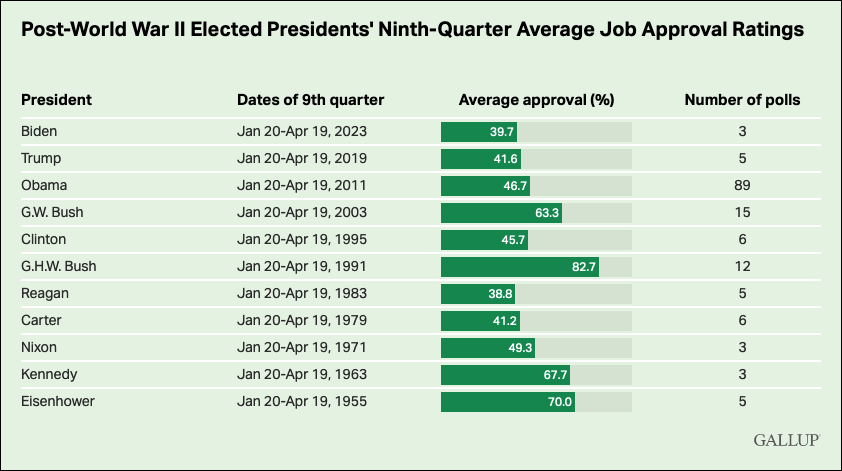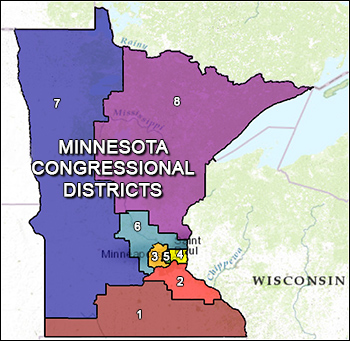By Jim Ellis — Monday, May 8, 2023
President
Polling Numbers: The Good, The Bad & The Ugly — The Gallup organization last week released their historical comparison of commensurate modern-era presidential job approval ratings, and it appears that a high positive score is not necessarily a prerequisite for winning re-election; nor is a poor one a precursor for defeat.
Gallup listed the presidents from Joe Biden back through Dwight Eisenhower and captured their mean average job approval ratings from the period between January 20 and April 19 of the year prior to them seeking re-election. Presidents Gerald Ford, John Kennedy, and Lyndon Johnson are not included because they were either not in office during the sampled period (Ford) or did not seek re-election (Kennedy because he was assassinated, while Johnson chose not to run for a second full term).
Looking at the Gallup number for each tested president (the posted figure representing the average polling result for the number of surveys conducted during the aforementioned testing period), President Biden is the worst performer at 38.7 percent favorable; George H.W. Bush, at 82.7 percent, was rated the best.
As you can see solely from that data point, even having the best job performance rating in the early part of the year prior to re-election is no guarantee of winning. While Bush had one of the highest positive ratings on record, he would then post the lowest popular vote percentage (37.5) and the second-lowest electoral vote total (168) of the nine presidents who ran for re-election after 1950.
The reverse is true, as well. The second-worst job approval rating at a commensurate period in his presidency is Ronald Reagan’s 38.8 percent positive score. Reagan would then rebound to the point of recording the strongest re-election electoral vote total (525 of the 538 available votes) in modern political history, and the second-highest popular vote score at 58.8 percent. The only president who outperformed Reagan in terms of a percentage of aggregate votes recorded was Richard Nixon’s 60.7 percent in 1972. Less than two years later, however, Nixon would be forced to resign in disgrace over the Watergate scandal.
Of the nine presidents since 1950 who ran for a second term, six were re-elected (Eisenhower, Nixon, Reagan, Bill Clinton, George W. Bush, and Barack Obama). Three were defeated (Jimmy Carter, George H.W. Bush, and Donald Trump).
In terms of those defeated, Carter’s job approval rating during the tested period was 41.2 percent, Bushes, as cited above, was 82.7 percent, while Trump’s was 46.8 percent.
Interestingly, both Bush’s significantly under-performed in their re-elections. George H.W. Bush dropped 45.2 points from his job approval score in the first quarter of the year before re-election compared to his popular vote total. His son, George W. Bush, was second in this category. While winning a second term with 50.7 percent of the vote, he dropped 12.6 points from his average first quarter 2003 job approval score of 63.3 percent. President Carter came the closest between early job approval, 41.2 percent, and his re-election popular vote total, 41.0 percent. His 49 electoral vote total in 1980, however, was by far the worst among the tested presidents.
Among those 10 presidents, including Biden, the average approval rating is 51.8 percent positive, while the average succeeding popular vote total was 50.3 percent (54.6 percent among the six winning presidents; 41.8 percent among the three losing chief executives).
While it is obviously better to be in a stronger job approval position heading into an election, having an upside-down ratio is not always disastrous. Conversely, as we’ve seen from the Bushes, posting high approval ratings the year prior to re-election is also no guarantee of success at the ballot box.
The fact that President Biden is on the low end of the approval rating index at this point in his presidency is not necessarily a cause for panic for Democrats, nor is it an ironclad prediction factor that he will lose the 2024 election. It is an indication, however, that he will have to pick up the pace of creating a better image and improving his perceived success rate regarding the handling of key issues.


